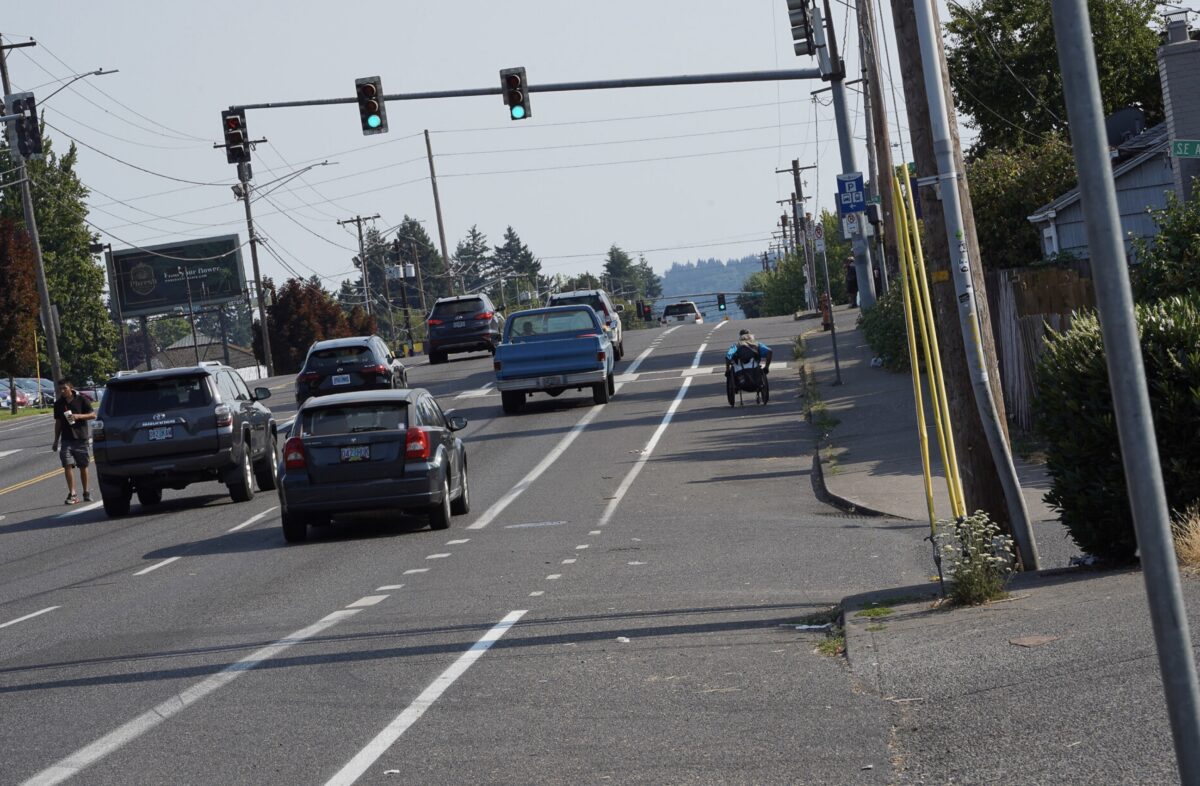
The Portland Bureau of Transportation is working on a plan to give east Portland’s 122nd Avenue a makeover, and it now has feedback from community members about what they think should be prioritized. Topping the list is a redesigned 122nd and East Burnside intersection and more trees to provide some shade.
On the 6.5 mile section between NE Marine Drive and SE Foster Road, 122nd Avenue is one of Portland’s most dangerous streets. Someone walking, biking or taking the bus on 122nd will notice there are stretches of the wide multi-lane arterial without sidewalks, and many that do exist are narrow, deteriorated and/or impeded by utility poles and bus stops. There is a lack of streetlight coverage, making people particularly vulnerable at night. And 122nd’s bike lanes are very narrow, unprotected from car traffic and drop off to become shared turn lanes with cars.
These are just some of the issues highlighted in our video back in September.
Advertisement
In September, PBOT released an online open house to seek final community input before drafting the 122nd Ave Plan. The open house was live more a month and a half, and more than 330 people participated. PBOT recently released a summary of information about the they received about the project, giving us an idea of what we can expect to see prioritized in the plan.

According to the summary, people support intersection redesigns, improved bike and pedestrian facilities, transit access improvements, improved lighting, and investment in trees and greenery. People are most concerned about congestion relating to any reduction in space for driving and some are apprehensive about “too much” investment in bike infrastructure. Other people in the community have also suggested more traffic speed enforcement.
E Burnside Street was the top intersection survey respondents said they wanted redesigned to improve safety and predictability of movement, followed by NE Halsey St, NE Glisan St, SE Powell Blvd and NE Fremont St (see chart above). According to PBOT, these safety improvements could be made in different ways (see below).
One potential is to keep the existing number of standard lanes, but narrow them to allow for an expanded bike lane along the curb, and make it so cars can’t turn right across the bike lane on a red light. A more sweeping redesign might involve removing the exclusive right-turn lane for a completely protected intersection for people biking, and a shorter crossing distance for people walking across the street.
An area where PBOT is considering making significant changes is between SE Foster Road and SE Powell Blvd, where they want to reduce standard thru-lanes from two in each direction to one, which would open up space for a center median and safer crossings, bike lanes and transit stops.
About 40% of respondents said they wanted a design that provided the most protection for people biking and walking.
Although PBOT says traffic analysis shows this lane reduction wouldn’t result in a significant increase in traffic congestion, they said feedback on this topic showed a “tension between those wanting more separation and those wanting to preserve traffic lanes and along the corridor.” About 40% of respondents said they wanted a design that provided the most protection for people biking and walking, but some people were concerned this extra protection would lead to increased travel times for people driving cars.
One thing that’s not up for debate? Community members want increased plant and tree coverage. PBOT says the investment in greenery is something that was most pressing for many people who responded to the survey. As the June 2021 heat wave made very clear, areas in Portland with the least amount of tree canopy coverage and widest roads experienced the hottest temperatures. According to PBOT, some neighborhoods near 122nd Ave experienced the highest number of deaths during this heat wave.
“One of the reasons it sucks to walk in east Portland is we have no large trees on the arterials and the concrete creates a heat island. We really need more vegetation,” one person wrote in the project survey.
122nd Ave is located in an area where there are higher concentrations of communities of color and low-income people. People of color and lower-income people are overrepresented in traffic fatalities. In order to achieve a just transportation system where everyone has the freedom of mobility, it’s vital to make it safe to travel on streets like 122nd Ave.
PBOT says they will release a draft of the 122nd Ave Plan using this community input later this year, after which point there will be another public comment period. You can find the full fall 2021 survey summary here, and stay tuned for more information about what we hope will be a boon to safety in east Portland.



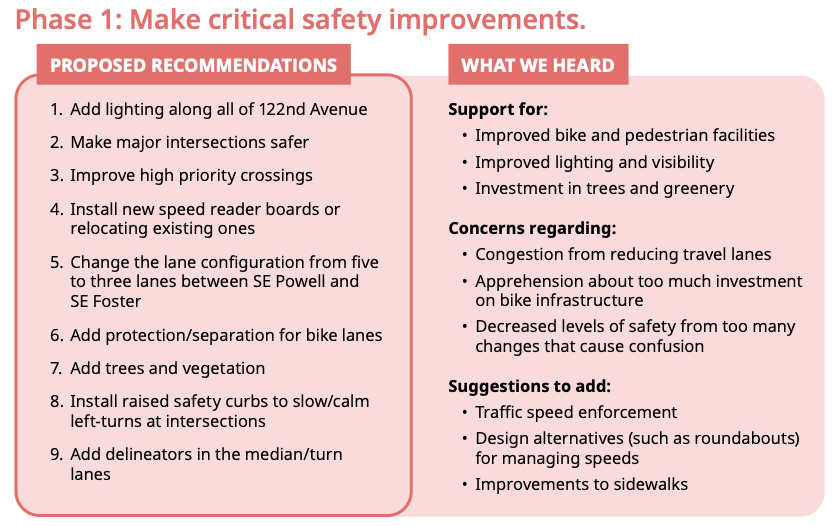
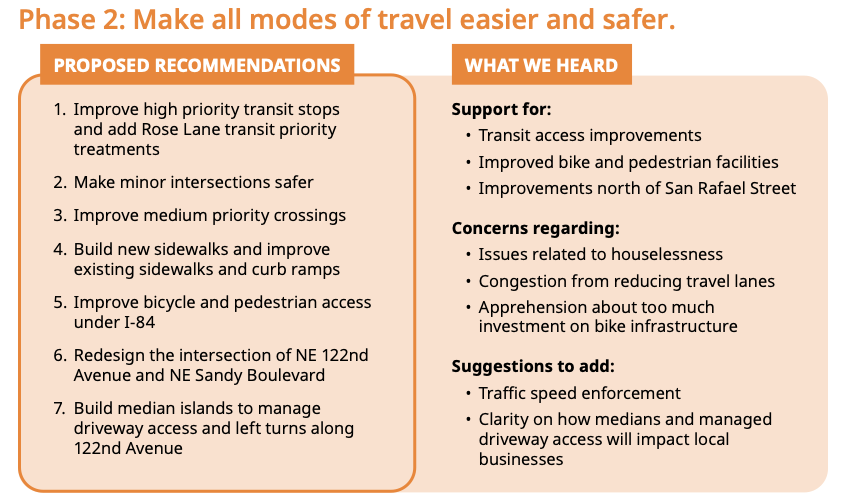
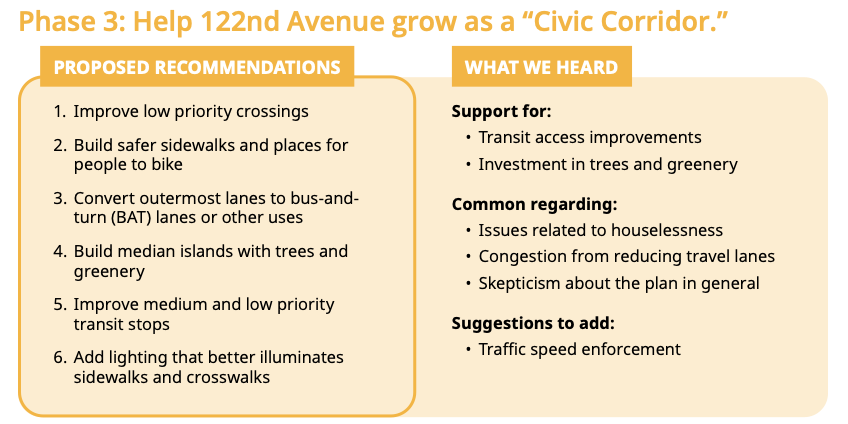



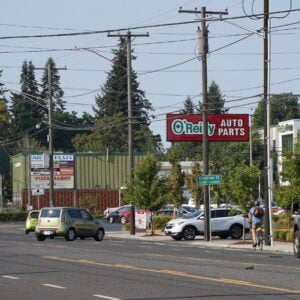
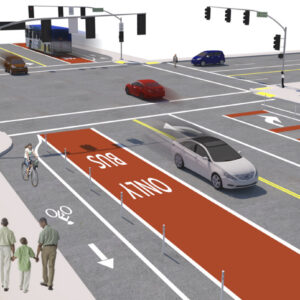


Thanks for reading.
BikePortland has served this community with independent community journalism since 2005. We rely on subscriptions from readers like you to survive. Your financial support is vital in keeping this valuable resource alive and well.
Please subscribe today to strengthen and expand our work.
I live within 6 blocks of 122nd Ave. Interesting, I can’t say I ever saw any notice of public input.
I could have shared many stories of people who have joined Soren’s Church of Ignoring Inconvenient Laws. Speeding at easily 45 mph+, blowing through stop signs, red lights, not giving pedestrians any room, etc.
It’s so heartening to see my neighbors being such pillars of the community and fine examples of how people should behave on the streets of Portland/Metro.
The first “Point of Unity” of Soren’s Scofflaw Collective* is to violate laws safely and in a manner that respects the right of way of others (yes, even cage drivers).
The second is that the first POU only applies to vulnerable traffic.
When I drive my e-cage, I make a point of assiduously following traffic laws. For example: driving ~25 mph on Powell or 82nd is fun!
*Soren does not do “churches” except in a Goth ironic manner.
Church, Cult, Collective, whatever you want to call it. They follow your example that a person can break laws whenever they want under the conditions of their own choosing.
Are you so full of yourself that you get to make up your own rules and think that because Soren broke the law it’s perfectly fine, but if “cager” over their breaks it isn’t because Soren ordanes it?
Wow, you are a piece of work.
Interesting photo. In one single image we have:
A truck is riding the bike lane.
A pedestrian ambling down the turn lane.
A wheelchair is in the parking zone.
That is some crazy multi-modal use of a public thoroughfare!
Missed noting the sidewalk too:
Blocked with overgrown vegetation.
Blocked by sign posts.
Blocked by utility and signal poles and their associated guy wires.
It’s a woonerf!
It’s a disaster…. It’s East Portland.
PBOT has been working on a plan for 122nd for over 10 years. While sidewalks and crossings have been added at strategic areas there is still a long way to go.
If there’s no plan in place how can it be funded? Exactly why PBOT has taken their time.
PBOT needs to do a better job educating people for these surveys. They need to understand that if they want more street trees and safer facilities for pedestrians and cyclists it will come with the cost of increased travel times for people driving. That’s just how it works. Every time they do a redesign in East Portland my local neighborhood social media pages explode with complaints about underutilized pedestrian and bike facilities, increased congestion and cut through traffic. Many of the people complaining also complain about the lack of safety and investment in East Portland. They have this unrealistic expectation of a road that can act like a freeway but be safe like an out of the way neighborhood street.
Counterpoint: could making the tradeoff more visible actually decrease support for for “safer streets”?
In other words, if PBOT explicitly ties an increase in safety to lower driving speeds, won’t many people oppose safety improvements because they don’t want their personal automotive travel times to increase?
Personally, I’m pretty happy when local safety improvements slow down my car driving… but that’s because I ride a bike a lot of the time, and I appreciate the personal safety benefit that accrues to me. If I wasn’t a rider, I would experience longer travel times as an inconvenience.
Your proposal might shift the opinions of some small number of voters who are willing to make some personal sacrifice for safety, but it might also shift the opinions of a larger number of voters, who previously did not care, but, once they’ve heard about the issue, are not willing to make some personal sacrifice.
That would be a perverse incentive structure, in which the framing of the issue could create greater interest and opposition in a skeptical majority, as opposed to the passionate minority (advocates for vulnerable road users).
As it is, some beneficial changes might occur “under the radar” of less politically engaged voters who drive, as long as the messaging doesn’t awaken them to the reality that their drive to work will take two minutes longer, on average.
Maybe the best way mirrors “secret Congress,” in which bi-partisan legislation passes only because the Democratic Party and GOP have a tacit agreement not to campaign on the issue. If, instead, Biden or Trump were to start speaking in favor or in opposition, the legislation would become polarized, and thus fail, thanks to the filibuster.
I don’t have a statistical answer to this question. Maybe there are actually a lot of people out there who are willing to sacrifice speed and convenience for us vulnerable road users (and, to a degree, themselves).
However, I don’t see a lot of evidence for it. Since I started reading BP in 2008, I’ve seen many, many articles about local opposition to road safety improvement, even from the bluest, bikiest neighborhoods in this very blue, very bikey city. Even people who sorta care about road safety are often annoyed and unsupportive of road designs that inhibit their speed and convenience.
All of that makes perfect sense and I do agree that some people who want safety improvements would oppose them if they knew it also would involve inhibiting travel times. As you say the number of people in that group is unknown but large or small I still think it’s the better approach.
I think engaging the community with these surveys while misleading them just results in more resentment and opposition to any future projects. It may be a tough messaging campaign but in the long run I think the results would be better. The current method just creates a group of people that don’t trust anything the PBOT does.
Maybe! Perhaps in the venue of a neighborhood association, the people who would hear a safety-first message from PBOT would respond better than the population at large.
Jonathan, Great photo depicting the design or operational “tragedy” that is this modern transport corridor: a person in a wheel chair having to travel in the parking lane/ bike lane since the walkways are missing ramps or sections and the pedestrian attempting to cross the roadways at an unmarked crossing.
This roadway is well above its thru volume capacity for the deficient supporting infrastructure.
The photo at the top of this article speaks volumes. I use to bike SE 122nd regularly. Its non-motor vehicle traffic is made up of a few “strong and the fearless cyclists” and all those other non-drivers who have few or no other options.
Looks like there’s not a single vehicle parked on 122nd in the above image. So why do we need so much room dedicated to parking? Just remove the parking and narrow bike lanes and replace then with protected multi-use paths on each side of the street. Problem solved immediately; it’s a win-win for everyone. Anyone who wants to park can park on one of the many other streets in the area; it’s not like this is 23rd Avenue where the parking is always full. Plant trees where the old sidewalk used to be that would now be no longer needed due to the wide MUPs.
To solve the problems at intersections, just remove any dedicated right-turn lanes and continue the protected MUPs through in the protected intersection style shown above. It’ll result in an ever-so-slightly higher travel time for people in vehicles, but that’s a very worthy trade-off for safety.
Problem solved. PBOT making everything way harder than it needs to be, yet again.
I’m not shocked that the new median dividers on Division east of 82nd are not also planters and bioswales. I don’t believe that would have happened west of 82nd. Seems like a pretty significant lost opportunity.
The new medians on Division were planned to have trees/love vegetation but were excluded in most locations by conflicts with large water/sewer lines and gas lines. These cannot be easily relocated and cannot have large trees above them. Low vegetation without trees is deemed too much maintenance for too little benefit- without shade and irrigation, it is very difficult to keep vegetation alive in the middle of a large road.
Anyone from PBOT mention rephasing traffic lights? At least here in Beaverton on the 8 and 10, lights–in addition to being spaced too far apart–have incredibly long cycles that not only encourage high vehicle speeds and red-light running, but also force needlessly long wait times for cross traffic, worsening local air pollution. If overall vehicle speeds are lower but people aren’t sitting at reds for so long, it’s a win for everybody.
Oh, and getting rid of slip lanes (those right turn-only lanes), or using pedestrian-leading crossing signals, is a no-brainer. Personal experience says that unless you’ve made eye contact with people in those lanes, people will absolutely just roll through a right-on-red without thinking there’s someone waiting to cross.